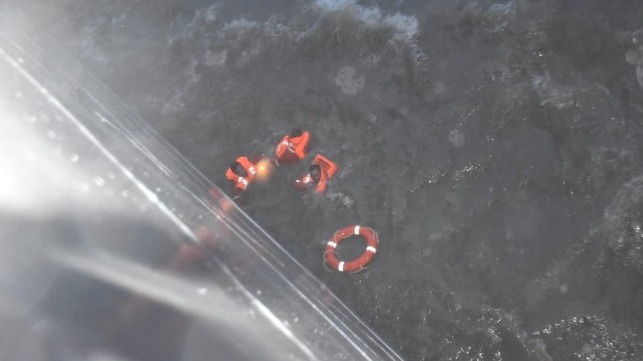26 Dead, 49 Missing in Indian Offshore Barge Sinking

The Indian Navy reported Wednesday that at least 26 people from the sunken accommodations barge P305 are dead, and 49 are still missing. 186 survivors have been pulled from the water.
The P305 went down off Mumbai on Monday evening during Cyclone Tauktae, which brought winds of up to 110 miles per hour and waves of up to 26 feet to the region. P305 was one of three accommodations and work barges that broke loose from their moorings in the Bombay High region, prompting a challenging search, rescue and evacuation effort for hundreds of affected workers. The Indian Coast Guard, Indian Navy and good samaritan vessels rescued all personnel from the other two barges, including one that ran aground.
According to former Indian Navy spokesman Capt. DK Sharma (ret'd), the destroyer INS Kochi was responsible for rescuing over 120 victims of the P305 sinking, maneuvering through extreme waves and winds to reach the survivors and bring them on board. One of the P305's crewmembers told ANI that he was in the water for 11 hours before his rescue.
No words would be enough to Thank our officers & men who are leaving no stone unturned to Search & Rescue survivors of barge P305 which went down in the aftermath of #CycloneTaukte.
— Captain DK Sharma (@CaptDKS) May 19, 2021
They are at it & won't give up till the last man is picked up @indiannavy @abhilashtomy pic.twitter.com/J9rumvsQEV
Indian Navy continues its search and rescue operation for missing crew members of Barge P305 adrift in Mumbai; visuals from the rescue operation conducted by INS Kochi
— ANI (@ANI) May 19, 2021
(Source: Indian Navy) pic.twitter.com/D12rw2U0li
Video of rescue ops from sunken barge P305 off Mumbai coast by INS Kochi #CycloneTaukte
— Dinakar Peri (@dperi84) May 19, 2021
VC: @indiannavy pic.twitter.com/w0K6AtpQ9J
The storm's formation was forecast more than a week in advance, and the Indian Coast Guard had been in contact with fishermen and with the oil industry about making preparations. While some 6,000-plus boats from the region's artisanal fishing industry headed back to port and largely escaped damage, oil and gas operators had fully-manned assets in harm's way and were hit hard. In addition to the 600-plus personnel adrift on three barges in extreme weather, the drillship Sagar Bhushan and the tanker Desh Bhakt also lost their moorings. Desh Bhakt was on a dangerous drift course towards the offshore rig Vivekanand-2 until she restored propulsion, according to officials.
India's Ministry of Petroleum and Natural Gas announced Wednesday that it has created a three-member panel to examine the sequence of events leading up to the unprecedented multi-vessel incident, along with the quality of the emergency response.
Additional, less-critical SAR response efforts continued Wednesday. The Indian Coast Guard cutter Samrat assisted a partially-flooded offshore tug, the Sangita, at a position off the coast of Daman. Towing arrangements are being made. Two drifting freighters, the Denali and Samarpan, are now considered safe, with one anchored and one drifting in a non-hazardous area.
Meanwhile, the Indian maritime sector's all-out effort to support COVID relief is still well under way. As the country's severe outbreak continues, oxygen supplies, tanks and related materials are taking top priority at Indian ports, with dockers working around the clock.
NOTHING CAN STOP US!
— Ministry of Ports, Shipping and Waterways (@shipmin_india) May 18, 2021
Amidst the challenges of the cyclone & severe weather conditions, we bring to you exciting visuals from @JNPort as the port operating team handled the consignment of oxygen#Unite2FightCorona@MansukhMandviya @MoHFW_INDIA @mygovindia @PIB_India @MIB_India pic.twitter.com/0HqqIsIKjR
Another major cyclone is expected next week in the Bay of Bengal, which currently has the highest ocean temperatures in the world at up to 90 degrees Fahrenheit, according to extreme weather expert Dr. Jeff Masters. Warm waters fuel tropical cyclone development.
The hottest ocean temps in the world now are in the Bay of Bengal: up to 32°C (90°F)--plenty of raw energy to power the cyclone the GFS and Euro models are predicting will form next week. These models successfully predicted Tauktae's formation over a week in advance. pic.twitter.com/erK34pY7bC
— Jeff Masters (@DrJeffMasters) May 19, 2021
